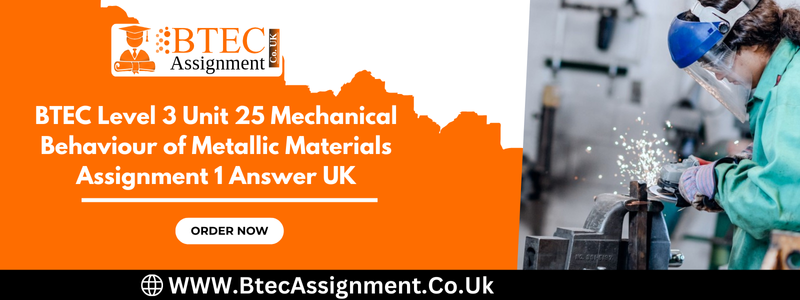BTEC Level 3 Unit 25 Mechanical Behaviour of Metallic Materials Assignment 1 Answer UK

The knowledge of mechanical behavior in metallic materials falls within the learning outcomes of Unit 25 of the BTEC Level 3 Extended Diploma in Engineering. The unit also encompasses metals under tension, compression, and shear. Commonly encountered notions will include stress, strain, elasticity, plasticity, and fracture. The properties the metallic materials possess are discussed, as well as applications and performance under different environmental conditions. This unit will prepare students, through practical experiments and analysis, for applying knowledge in real-world engineering situations, extending their capability in material selection and mechanical design in a wide variety of engineering applications.
Get Expert Solutions for Unit 25 Assignment 1: Mechanical Behaviour of Metallic Materials in the UK
Looking for help with Unit 25 Mechanical Behaviour of Metallic Materials Assignment 1? Our UK-based service provides tailored solutions of 100% original work with BTEC Level 3 Engineering. Help with essays, coursework, research papers, and homework-assured extended team support that shall guarantee top grades to students. With extensive knowledge about metallic materials, accurate and quality solutions to the problems will be provided. Never let challenges in assignments get in your way when expert help is just what complements the best. Allow us to assist you in securing a high score with your BTEC Level 3 Engineering assignment!
Task 1: Describe the Mechanical Properties of Metallic Materials
This project involves discussing important mechanical properties of metallic material behavior. Start by defining some key properties like:
Tensile Strength: This is the maximum quantity of stress a metallic material can bear while being pulled or stretched before ultimate failure. Relate it to engineering applications, such as in construction or manufacturing, where materials are supposed to bear pulling.
Ductility: The term refers to the plastic deformation of a material without fracturing. Ductility is an important factor in materials that should be shaped or stretched into wires or sheets.
Hardness: It is defined as the resistance of a material against deformation, especially permanent indentation. Discuss different types of hardness, for example, Brinell and Rockwell, together with their importance when estimating the wear resistance of metals.
Toughness: Energy that a metal can absorb without fracturing while deforming plastically. Explain why toughness is an important factor in the application of metals in situations involving impact or sudden forces.
Elasticity and Plasticity: Elasticity is the material property to revert back to its originally applied shape when the load is removed; whereas plasticity means the ability of material for permanent deformation in shape. Discuss their role in design considerations.
Use examples of specific metallic materials, such as steel or aluminum, to illustrate how these properties affect their practical use in engineering contexts.
Task 2: Research the Heat Treatment Process on Mechanical Properties of Metallic Materials
In this task, research how the heat treatment process influences the mechanical properties of metallic materials. The discussion of the following heat treatment processes should be considered:
Annealing: Annealing temperature application to a steel metal for a certain time, followed by gradual cooling can yield increased ductility with reduced hardness for ease of working the material.
Quenching: Quenching involves sharp cooling of previously heated metals at high temperatures in water or oil. Quenching increases hardness and strength; it may decrease ductility.
tempering: In this process, the quenched metal is re-heated to a temperature below its lower critical temperature. Discuss how this improves the balance of hardness and ductility by relieving brittleness.
Use suitable examples to discuss aspects such as how annealing improves workability in steel or how quenching followed by tempering gets cutting tools to their desired state of hardness. Also comment on how such treatments affect tensile strength, toughness, and hardness.
Task 3: Stress-Strain Relationship in Metallic Materials – Analysis
In this question, discuss stress vs. strain and their relationship to the mechanical behavior of metallic materials. Start by defining both stress and strain:
Stress: the internal force that is applied to a material, per unit area, whereas the external force applied to the material is an externally applied tensile or compressive force.
Strain: deformation of material, or change in length, compared to its original length caused by applied stress. Now, describe the regions of a typical stress-strain curve, including
Elastic Region: The region in which a material deforms elastically; that is, it is linear and the stress is proportional to strain by Hooke’s Law. Once the stress is removed, the material will return to its original shape.
Yield Point: The amount of stress that, once reached, the material will begin to deform plastically. Past this limit, once the load is removed, the material will not return to its original shape.
Plastic Region: The material has been permanently deformed.
Ultimate Tensile Strength (UTS): The maximum amount of stress a material can withstand before necking.
Fracture Point: Where the material finally breaks.
Use diagrams to illustrate the stress-strain curve and provide examples of how different metals, such as copper or aluminum, would behave under stress.
Exercise 4: Evaluate Applications of Different Metallic Materials Whose Mechanical Properties Have Been Determined
Evaluate applications of different metallic materials based on their mechanical
properties. As an example:
Steel: It is a very hard and strong element with high tensile strength. This makes broad applications of the metal in the construction, automotive, and manufacturing industries.
Aluminum: The ratio of its strength to weight, corrosion resistance, and ductility enable it to be used in aerospace, transportation, and packaging industries.
Copper: Copper has excellent electrical conductivity, ductility, and corrosion resistance.
Get Your 100% Plagiarism-Free, High-Quality BTEC Assignments with Just One Click
Finding it difficult to work on your BTEC assignments? Our team of experts will help you with superior BTEC assignment help to provide you with 100% plagiarism-free solutions according to your needs. Whether you want BTEC Level 3 assignment help or help on particular coursework, essays, or research papers assistance is covered. If you are looking for quality, this UK-based service assuredly will give you reliable support for all your academic needs. Stop freaking out due to assignment challenges; let us take care of it. Click here for the best “do my assignment UK” service, now for professionals that will make sure you succeed academically.




